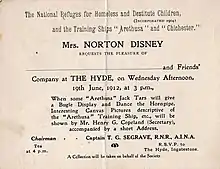HMS Arethusa (1849)
HMS Arethusa was a 50-gun fourth-rate sailing frigate of the Royal Navy, was launched in 1849 from the Pembroke Dockyard and served in the Crimean War. In 1861 she was converted to a steam screw frigate. Decommissioned in 1874, Arethusa became a school and training ship on the River Thames, preparing young boys for maritime careers, until she was broken up in 1934.
 Preserved Arethusa figurehead in Upnor on the River Medway | |
| History | |
|---|---|
| Name: | HMS Arethusa |
| Ordered: | 19 February 1844 |
| Builder: | Pembroke Dockyard |
| Laid down: | 30 March 1846 |
| Launched: | 20 June 1849 |
| Completed: | 20 March 1850 |
| Reclassified: | Training ship in 1874 |
| Fate: |
|
| General characteristics as sailing frigate | |
| Class and type: | Constance-class frigate |
| Tons burthen: | 2,125 75⁄94 bm |
| Length: |
|
| Beam: | 52 ft 8 in (16.05 m) |
| Depth of hold: | 16 ft 3 in (4.95 m) |
| Sail plan: | Full-rigged ship |
| Crew: | 500 |
| Armament: |
|
| General characteristics as screw frigate | |
| Displacement: | 3,708 tons |
| Tons burthen: | 3,142 33⁄94 bm |
| Length: |
|
| Beam: | 52 ft 8 in (16.05 m) |
| Draught: |
|
| Depth of hold: | 17 ft 1 in (5.21 m) |
| Installed power: | 3,165 ihp (2,360 kW) |
| Propulsion: |
|
| Sail plan: | Full-rigged ship |
| Speed: | 11.704 knots (21.68 km/h; 13.47 mph) |
| Crew: | 525 |
| Armament: |
|

Construction
HMS Arethusa was ordered in 1844 from the Pembroke Dockyard as a repeat of the frigate HMS Constance and was launched on 26 June 1849.[1] She had a tonnage of 2,132 and was designed with a V-shaped hull by Sir William Symonds.[1] She was of all-wooden construction.
Naval service
Arethusa saw service during the Crimean War,[2] On 29 October 1853, she ran aground in the Dardanelles. She was refloated the next day after her guns had been removed to lighten her.[3] Arethusa took part in battles at Odessa and Sevastopol. At the time of the battle in 1854 she was captained by William Robert Mends and was the last major ship of the Royal Navy to enter an engagement under sail power alone.[2][4]
In 1860-1861 Arethusa was lengthened and converted to screw propulsion at Chatham Dockyard, with a steam trunk engine made by John Penn and Sons, London.
Training ship
Once decommissioned, in 1874, the ship's engines were removed and she was loaned by the Admiralty to the charity that later became known as Shaftesbury Homes and Arethusa.[1] Retaining the name Arethusa, she was moored next to their existing training ship Chichester at Greenhithe, Kent. Shaftesbury Homes provided refuge and taught maritime skills to destitute young boys who had been sleeping rough on the streets of London and trained them for a career in the Royal Navy or Merchant Navy.

In 1933 the wooden frigate was no longer viable, and was replaced by the steel-hulled ship Peking, which was moored at Upnor on the Medway, and renamed Arethusa. The frigate returned to the Admiralty, was sold to Castle's Shipbreakers on 2 August 1933 and demolished at Charlton, London in the following year.[1] The frigate's figurehead, originally carved by the Hellyer family, was retained by the school and displayed onshore at Upnor, where it remains after restoration in 2013.[5][6]
References
- Winfield, David Lyon & Rif (2004). The sail & steam Navy list : all the ships of the Royal Navy 1815 - 1889. London: Chatham. pp. 104, 206. ISBN 1-86176-032-9.
- "William Loney RN - Background". Retrieved 8 April 2014.
- "The Combined Fleets of England and France". The Morning Chronicle (27117). London. 21 November 1853.
- The Oxford Illustrated History of the Royal Navy, p. 174, Ranft, Bryan, Oxford University Press, 2002
- "Commissions". Maritima Woodcarving.
- Hughes, Rebecca (29 May 2013). "Figurehead of the war ship Arethusa in Lower Upnor has been restored after a wasp attack". kentonline.co.uk. Retrieved 8 April 2014.